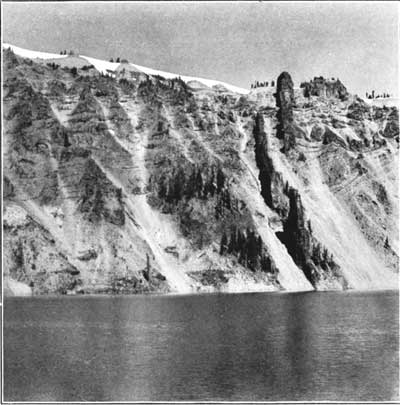Geological History of Crater Lake
National Park
At times of volcanic eruption the lava rises within the volcano until it either overflows the crater at the top or, by the great pressure of the column, bursts open the sides of the volcano and escapes through the fissure to the surface. In the latter case, as the molten material cools, the fissure becomes filled with solid lava and forms a dike. The best example of this sort about Crater Lake appears along the inner slope directly north of Wizard Island, and is locally known as the Devils Backbone. It is shown in figure 5 across the left end of Wizard Island and in figure 18 a nearer view from the island itself. This dike rock, standing on edge, varies from 5 to 25 feet in thickness and cuts the rim from water to crest. Dikes are most numerous in the older portion of the rim under Llao Rock. They do not cut up through Llao Rock and are clearly older than the lava of which that rock is formed. Dikes occur at intervals all around the lake and radiate from it, suggesting that the central volcanic vent from which they issued must have been Mount Mazama.
FIG. 18—THE DEVILS BACKBONE AS SEEN FROM WIZARD ISLAND.There is another important feature concerning the kinds of volcanic rocks and their order of eruption and distribution about the rim of Crater Lake as shown on the accompanying reconnoissance map, figure 13, that is of much interest to the geologist. All the older lavas comprising the inner slope of the rim, especially toward the water's edge, are andesites. The newer ones, forming the top of the rim in Llao Rock, Pumice Point, Roundtop, and the Rugged Crest about the head of Cleetwood Cove as well as at Cloudcap, are dacites. Other later flows, all of which escaped from the smaller adnate cones upon the outer slope of the rim, are basalts. The eruptions began with lavas containing a medium amount of silica (andesites), and after long-continued activity lavas both richer (dacites) and poorer (basalts) in silica follow, giving a completeness to the products of this great volcanic center that make it an interesting field of study. Furthermore, the remarkable opportunity afforded by the dissected volcano for the examination of its structure and succession of lavas is unsurpassed. It should be stated, before dismissing the kinds of lava, that there are some dacites in the Sun Creek Canyon south of the lake that appear to be older than those upon the north side, and that the final lava of the region on Wizard Island is andesite.
FIG. 19—LAYERS OF DACITIC PUMICE AND TUFF IN PUMICE POINT, THE UNDER-LYING ANDESITIC LAVA BEARS GLACIAL STRIAE.
 |
 |

